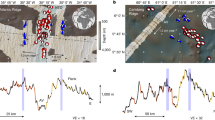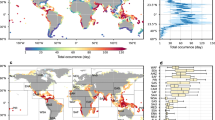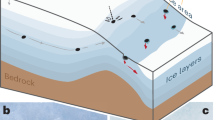Abstract
One of the most powerful features of plate tectonics is that the known plate motions give insight into both the locations and average recurrence interval of future large earthquakes on plate boundaries. Plate tectonics gives no insight, however, into where and when earthquakes will occur within plates, because the interiors of ideal plates should not deform. As a result, within plate interiors, assessments of earthquake hazards rely heavily on the assumption that the locations of small earthquakes shown by the short historical record reflect continuing deformation that will cause future large earthquakes1. Here, however, we show that many of these recent earthquakes are probably aftershocks of large earthquakes that occurred hundreds of years ago. We present a simple model predicting that the length of aftershock sequences varies inversely with the rate at which faults are loaded. Aftershock sequences within the slowly deforming continents are predicted to be significantly longer than the decade typically observed at rapidly loaded plate boundaries. These predictions are in accord with observations. So the common practice of treating continental earthquakes as steady-state seismicity overestimates the hazard in presently active areas and underestimates it elsewhere.
This is a preview of subscription content, access via your institution
Access options
Subscribe to this journal
Receive 51 print issues and online access
$199.00 per year
only $3.90 per issue
Buy this article
- Purchase on Springer Link
- Instant access to full article PDF
Prices may be subject to local taxes which are calculated during checkout


Similar content being viewed by others
References
Shedlock, K. M., Giardini, D., Grünthal, G. & Zhang, P. The GSHAP global seismic hazard map. Seismol. Res. Lett. 71, 679–689 (2000)
Ogata, Y. & Shimazaki, K. Transition from aftershock to normal activity: the 1965 Rat Islands earthquake aftershock sequence. Bull. Seismol. Soc. Am. 74, 1757–1765 (1984)
Dieterich, J. H. A constitutive law for rate of earthquake production and its application to earthquake clustering. J. Geophys. Res. 99, 2601–2618 (1994)
Toda, S., Stein, R. S., Reasenberg, P. A., Dieterich, J. H. & Yoshida, A. Stress transferred by the 1995 Mw = 6.9 Kobe, Japan shock: effect of aftershocks and future earthquake probabilities. J. Geophys. Res. 103, 24,543–24,565 (1998)
Ziv, A. Does aftershock duration scale with mainshock size? Geophys. Res. Lett. 33 10.1029/2006GL027141 (2006)
Parsons, T. Global Omori-law decay of triggered earthquakes: large aftershocks outside the classical aftershock zone. J. Geophys. Res. 107 10.1029/2001JB000646 (2002)
Hammond, W. C., Kreemer, C. & Blewitt, G. in Late Cenozoic Structure and Evolution of the Great Basin—Sierra Nevada Transition 34–54 (Geol. Soc. Am. Spec. Pap. 447, 2009)
Wesnousky, S. G. Earthquakes, Quaternary faults, and seismic hazard in California. J. Geophys. Res. 91, 12587–12631 (1986)
Chang, W. L. & Smith, R. B. Integrated seismic-hazard analysis of the Wasatch front, Utah. Bull. Seismol. Soc. Am. 92, 1904–1922 (2002)
Ryall, A. Earthquake hazard in the Nevada region. Bull. Seismol. Soc. Am. 67, 517–532 (1977)
Ebel, J. E., Bonjer, K. P. & Oncescu, M. C. Paleoseismicity: seismicity evidence for past large earthquakes. Seismol. Res. Lett. 71, 283–294 (2000)
Stein, S. & Newman, A. Characteristic and uncharacteristic earthquakes as possible artifacts: applications to the New Madrid and Wabash seismic zones. Seismol. Res. Lett. 75, 170–184 (2004)
Newman, A. et al. Slow deformation and lower seismic hazard at the New Madrid Seismic Zone. Science 284, 619–621 (1999)
Calais, E. & Stein, S. Time-variable deformation in the New Madrid seismic zone. Science 5920, 1442 (2009)
Mazzotti, S., James, T., Henton, J. & Adams, J. GPS crustal strain, postglacial rebound, and seismic hazard in eastern North America: the Saint Lawrence valley example. J. Geophys. Res. 110 1029/2004JB0035900 (2005)
Tuttle, M. P., Al-Shukri, H. & Mahdi, H. Very large earthquakes centered southwest of the New Madrid seismic zone 5,000–7,000 years ago. Seismol. Res. Lett. 77, 361–380 (2006)
Crone, A. J. & Luza, K. V. Style and timing of Holocene surface faulting on the Meers fault, southwestern Oklahoma. Geol. Soc. Am. Bull. 102, 1–17 (1990)
Toda, S. & Stein, R. Response of the San Andreas fault to the 1983 Coalinga-Nunez earthquakes: an application of interaction-based probabilities for Parkfield. J. Geophys. Res. 107 10.1029/2001JB000172 (2002)
Savage, J. C. & Burford, R. O. Geodetic determination of relative plate motion in central California. J. Geophys. Res. 78, 832–845 (1973)
Stein, R. The role of stress transfer in earthquake occurrence. Nature 402, 605–609 (1999)
Zoller, G., Hainzl, S., Holschneider, M. & Ben-Zion, Y. Aftershocks resulting from creeping sections in a heterogeneous fault. Geophys. Res. Lett. 32 10.1029/2004GL021871 (2005)
Hearn, E. H., Bürgmann, R. & Reilinger, R. E. Dynamics of Izmit earthquake postseismic deformation and loading of the Düzce earthquake hypocenter. Bull. Seismol. Soc. Am. 92, 172–193 (2002)
Kafka, A. in Continental Intraplate Earthquakes: Science, Hazard, and Policy Issues (eds Stein, S. & Mazzotti, S.) 35–48 (Geol. Soc. Am. Spec. Pap. 425, 2007)
Crone, A. J. et al. Paleoseismicity of two historically quiescent faults in Australia: implications for fault behavior in stable continental regions. Bull. Seismol. Soc. Am. 93, 1913–1934 (2003)
Holbrook, J. et al. Stratigraphic evidence for millennial-scale temporal clustering of earthquakes on a continental-interior fault: Holocene Mississippi River floodplain deposits, New Madrid seismic zone, USA. Tectonophysics 420, 431–454 (2006)
Camelbeeck, T. et al. in Continental Intraplate Earthquakes: Science, Hazard, and Policy Issues (eds Stein, S. & Mazzotti, S.) 193–224 (Geol. Soc. Am. Spec. Pap. 425, 2007)
Li, Q. & Liu, M. &. Stein, S. Spatiotemporal complexity of continental intraplate seismicity: insights from geodynamic modeling and implications for seismic hazard estimation. Bull. Seismol. Soc. Am. 99, 52–60 (2009)
Stein, S., Liu, M., Calais, E. & Li, Q. Mid-continent earthquakes as a complex system. Seismol. Res. Lett. 80, 551–553 (2009)
Kagan, Y. Y. & Jackson, D. D. Worldwide doublets of large shallow earthquakes. Bull. Seismol. Soc. Am. 89, 1147–1155 (1999)
Tuttle, M. P. et al. The earthquake potential of the New Madrid seismic zone. Bull. Seismol. Soc. Am. 92, 2080–2089 (2002)
Acknowledgements
We thank Y. Yang for assistance in preparing the figures and Supplementary Information, and H. Wang for providing the Chinese earthquake catalogue. M.L.’s research is supported by NSF/OISE grant 0730154 and a grant from the Chinese Academy of Sciences. We also thank E. Calais, A. Friedrich, R. Smith and R. Stein for discussions, and T. Parsons and Y. Kagan for reviews.
Author Contributions S.S. developed the friction-based model and much of the data set. M.L. developed the Chinese data and the viscous relaxation model. Both authors discussed the results and participated in the writing.
Author information
Authors and Affiliations
Corresponding author
Supplementary information
Supplementary Information
This file contains Supplementary Sources, Supplementary Data and Supplementary References to support Figures 1 and 2 in the main paper. (PDF 147 kb)
PowerPoint slides
Rights and permissions
About this article
Cite this article
Stein, S., Liu, M. Long aftershock sequences within continents and implications for earthquake hazard assessment. Nature 462, 87–89 (2009). https://doi.org/10.1038/nature08502
Received:
Accepted:
Issue Date:
DOI: https://doi.org/10.1038/nature08502
This article is cited by
-
The Mw = 5.8 2019 Silivri earthquake, NW Türkiye: is it a warning beacon for a big one?
International Journal of Earth Sciences (2024)
-
A machine learning algorithm with random forest for recognizing hidden control factors from seismic fault distribution
Geosciences Journal (2023)
-
Strong historical earthquakes and their relationships with the Tan-Lu fault system and modern seismicity in eastern China
Natural Hazards (2023)
-
Earth’s gradients as the engine of plate tectonics and earthquakes
La Rivista del Nuovo Cimento (2022)
-
A Short Note on the Aftershock Duration of Strong to Major Himalayan Earthquakes
Journal of the Geological Society of India (2022)
Comments
By submitting a comment you agree to abide by our Terms and Community Guidelines. If you find something abusive or that does not comply with our terms or guidelines please flag it as inappropriate.



